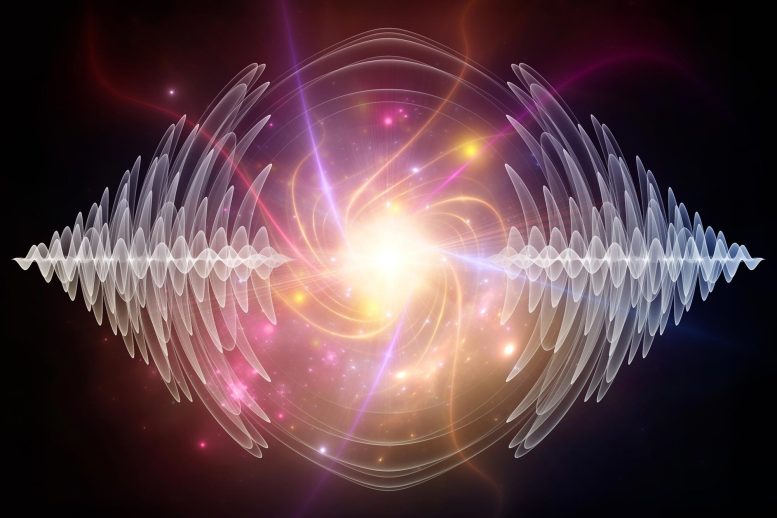
Nuclear physicists have discovered gravity’s profound influence on the quantum scale, revealing the strong force’s distribution within protons for the first time. This groundbreaking research, combining historical theoretical insights with modern experimental data, offers unprecedented understanding of the proton’s internal dynamics and sets the stage for future discoveries in nuclear science.
Nuclear physicists at Jefferson Lab have mapped the distribution of the strong force within the proton, employing a framework that links to gravity, opening a new pathway for exploration.
Gravity’s influence is unmistakably evident throughout the observable universe. Its effects are observed in the synchronized orbits of moons around planets, in comets that deviate from their paths due to the gravitational pull of large stars, and in the majestic spirals of enormous galaxies. These magnificent phenomena highlight the role of gravity on the grandest scales of matter. Meanwhile, nuclear physicists are uncovering the significant contributions of gravity at the very smallest scales of matter.
New research conducted by nuclear physicists at the U.S. Department of Energy’s Thomas Jefferson National Accelerator Facility is using a method that connects theories of gravitation to interactions among the smallest particles of matter to reveal new details at this smaller scale. The research has now revealed, for the first time, a snapshot of the distribution of the strong force inside the proton. This snapshot details the shear stress the force may exert on the quark particles that make up the proton. The result was recently published in Reviews of Modern Physics.
Insights into Proton Structure
According to the lead author on the study, Jefferson Lab Principal Staff Scientist Volker Burkert, the measurement reveals insight into the environment experienced by the proton’s building blocks. Protons are built of three quarks that are bound together by the strong force.
“At its peak, this is more than a four-ton force that one would have to apply to a quark to pull it out of the proton,” Burkert explained. “Nature, of course, does not allow us to separate just one quark from the proton because of a property of quarks called ‘color.’ There are three colors that mix quarks in the proton to make it appear colorless from the outside, a requirement for its existence in space. Trying to pull a colored quark out of the proton will produce a colorless quark/anti-quark pair, a meson, using the energy you put in to attempt to separate the quark, leaving a colorless proton (or neutron) behind. So, the 4-tons is an illustration of the strength of the force that is intrinsic in the proton.”
The result is only the second of the proton’s mechanical properties to be measured. The proton’s mechanical properties include its internal pressure (measured in 2018), its mass distribution (physical size), its angular momentum, and its shear stress (shown here). The result was made possible by a half-century-old prediction and two-decade-old data.
In the mid-1960s, it was theorized that if nuclear physicists could see how gravity interacts with subatomic particles, such as the proton, such experiments could reveal the proton’s mechanical properties directly.
“But at that time, there was no way. If you compare gravity with the electromagnetic force, for instance, there is 39 orders of magnitude of difference – So it’s completely hopeless, right?” explained Latifa Elouadhriri, a Jefferson Lab staff scientist and co-author on the study.
Theoretical Foundations and Experimental Breakthroughs
The decades-old data came from experiments conducted with Jefferson Lab’s Continuous Electron Beam Accelerator Facility (CEBAF), a DOE Office of Science user facility. A typical CEBAF experiment would entail an energetic electron interacting with another particle by exchanging a packet of energy and a unit of angular momentum called a virtual photon with the particle. The energy of the electron dictates which particles it interacts with in this way and how they respond.
In the experiment, a force even much greater than the four tons needed to pull out a quark/antiquark pair was applied to the proton by the highly energetic electron beam interacting with the proton in a target of liquified hydrogen gas.
“We developed the program to study deeply virtual Compton scattering. This is where you have an electron exchanging a virtual photon with the proton. And at the final state, the proton remained the same but recoiled, and you have one real very highly energetic photon produced, plus the scattered electron,” said Elouadhriri. “At the time we took the data, we were not aware that beyond the 3-dimensional imaging we intended with this data, we were also collecting the data needed for accessing the mechanical properties of the proton.”
It turns out that this specific process – deeply virtual Compton scattering (DVCS) – could be connected to how gravity interacts with matter. The general version of this connection was stated in the 1973 textbook on Einstein’s general theory of relativity titled ‘Gravitation’ by Charles W. Misner, Kip S. Thorne, and John Archibald Wheeler.
In it, they wrote, “Any mass-less spin-2 field would give rise to a force indistinguishable from gravitation, because a mass-less spin-2 field would couple to the stress–energy tensor in the same way that gravitational interactions do.”
Three decades later, theorist Maxim Polyakov followed up on this idea by establishing the theoretical foundation that connects the DVCS process and gravitational interaction.
“This breakthrough in theory established the relationship between the measurement of deeply virtual Compton scattering to the gravitational form factor. And we were able to use that for the first time and extract the pressure that we did in the Nature paper in 2018, and now the normal force and the shear force,” Burkert explained.
A more detailed description of the connections between the DVCS process and the gravitational interaction can be found in this article describing the first result obtained from this research.
Future Directions and Theoretical Advancements
The researchers say their next step is to work on extracting the information they need from the existing DVCS data to enable the first determination of the proton’s mechanical size. They also hope to take advantage of newer, higher-statistics, and higher-energy experiments that are continuing the DVCS research in the proton.
In the meantime, the study co-authors have been amazed at the plethora of new theoretical efforts, detailed in hundreds of theoretical publications, that have begun to exploit this newly discovered avenue for exploring the mechanical properties of the proton.
“And also, now that we are in this new era of discovery with the 2023 Long Range Plan of Nuclear Science released recently. This will be a major pillar of the direction of science with new facilities and new detector developments. We’re looking forward to seeing more of what can be done,” Burkert said.
Elouadhriri agrees.
“And in my view, this is just the beginning of something much bigger to come. It has already changed the way we think about the structure of the proton,” she said.
“Now, we can express the structure of subnuclear particles in terms of forces, pressure, and physical sizes that also non-physicists can relate to,” added Burkert.
Reference: “Colloquium: Gravitational form factors of the proton” by V. D. Burkert, L. Elouadrhiri, F. X. Girod, C. Lorcé, P. Schweitzer and P. E. Shanahan, 22 December 2023, Reviews of Modern Physics.
DOI: 10.1103/RevModPhys.95.041002
The study was funded by the US Department of Energy, National Science Foundation, Carl G. and Shirley Sontheimer Research Fund.









Please answer:
1. Why is mathematics the language of science?
2. What is the difference between low dimensional spacetime matter and high-dimensional spacetime matter in mathematics?
3. What exactly is quantum?
4. Is quantum necessarily high-dimensional spacetime matter?
5. Is the so-called academic journal you believe in scientific? Are they honest?
and so on.
Science must follow mathematical rules. For example, the Standard Model (SM) is considered to be one of the most significant achievements of physics in the 20th century. However, the magnetic moment of μ particle is larger than expected, revealed by a g-2 experiment at Fermilab, suggests that the established theory (such as SM) of fundamental particles is incomplete. Furthermore, the SM omitting gravity, it not involved the time problem and when the particle movement starts. Mathematics is the foundation of science. Physics must respect the scientific nature of mathematics and mathematical models. The SM must be based on mathematical models in order to be scientific, convincing, and in line with natural laws.
I hope researchers are not fooled by the pseudoscientific theories of the Physical Review Letters (PRL), and hope more people dare to stand up and fight against rampant pseudoscience.
The so-called academic journals (such as Physical Review Letters, Nature, Science, etc.) firmly believe that two high-dimensional spacetime objects (such as two sets of cobalt-60) rotating in opposite directions can be transformed into two objects that mirror each other, is a typical case of pseudoscience rampant.
If researchers are really interested in Science and Physics, you can browse https://zhuanlan.zhihu.com/p/643404671 and https://zhuanlan.zhihu.com/p/595280873.
The researchers are in an exact path to trace mechanical path for graviþy of quarks;Einstein’s GR is in good position applied to obtain result.Every aspect of the experiment is right;but,universe has a natural orientation to give perfect quantum gravity,not simpĺy the magntitude to establish in the laboratory otherwise achived from the other methods.
I just saw an article recently about the way a quasar that was billions of light years away, emitted photons and other cosmic particles, in these 2 huge jets that ejected from opposite sides. As the view gets farther and farther away, these 2 streams that look like a simple up and down motion, turns into a huge sweeping motion that almost resembles the first picture in this article. Spooky
Gravitational force field around the Earth varies significantly yet it is not recorded or felt because of the rotation planets and stars this can be calculated easily
I shall publish my new hypotheses shortly